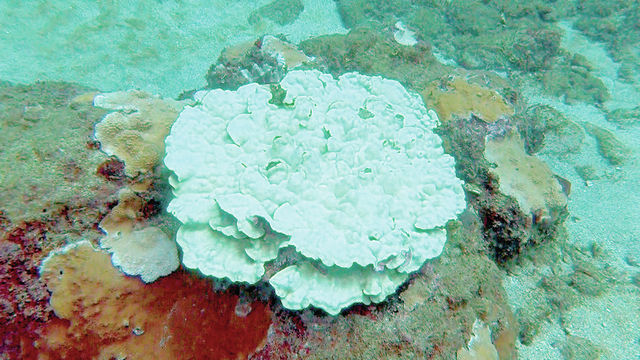LIHUE — Kauai’s colorful corals are going white, a crisis that is spreading and devastating reefs across the globe. Triggered by global warming and the El Nino, record hot ocean water is causing fragile coral to go white and often
LIHUE — Kauai’s colorful corals are going white, a crisis that is spreading and devastating reefs across the globe.
Triggered by global warming and the El Nino, record hot ocean water is causing fragile coral to go white and often die, threatening picturesque reefs that are hotspots of marine life, experts say.
The phenomenon is called bleaching because coral lose their color when they push out algae.
And scientists predict it’s going to get worse.
The spread of sickly white started more than a year ago in Guam, then devastated Hawaii, infected the rest of the tropical Pacific and the Indian oceans and has now infested Florida and the Caribbean. On Thursday, the National Oceanic and Atmospheric Administration and international reef scientists pronounced it a global coral bleaching event, only the third in recorded history.
“We may be looking at losing somewhere in the range of 10 to 20 percent of the coral reefs this year,” NOAA coral reef watch coordinator Mark Eakin said. “The bad news for the U.S. is we’re getting hit disproportionately just because of the pattern of the warming.”
No place with coral has been spared, though some regions — such as Hawaii — have been hit harder than others, experts said. Excessive heat stresses the living coral, which turns white and then becomes vulnerable to disease.
Eakin called bleaching a crisis, especially with worsening global warming forecast for the rest of the century: “If that’s not a crisis, what is?”
Eakin said he’s especially concerned about Hawaii, which already suffered through bad bleaching in 2014.
“Hawaii is getting hit with the worst coral bleaching they have ever seen, right now,” Eakin said. “It’s severe. It’s extensive. And it’s on all the islands.”
In one part of northwestern Hawaii, “the reef just completely bleached and all of the coral is dead and covered with scuzzy algae.”
It’s happening at a time when many Hawaii corals are just recovering from last year’s bleaching.
On Kauai, rising ocean temperatures may be causing problems beyond bleaching. Researchers say it may also be triggering the growth of a lethal, rapidly spreading coral disease found in nearshore waters called black band disease.
Warmer waters make coral more susceptible to disease.
The black band disease was first spotted at low levels on Kauai in 2004, then identified on the North Shore of Kauai in 2012 at 10 times background levels, according to the DLNR. It continues to plague the three Montipora (rice) corals found around the island.
The places most affected by the disease are the reefs surrounding Makua (Tunnels), Anini and Anahola beaches as well as Ahukini Landing, according to research by Christine Runyon, a graduate research assistant at University of Hawaii’s Institute of Marine Biology.
Hawaii experienced widespread coral bleaching for the first time since 1996. This year’s bleaching event marks the third time overall and the first time it has happened in consecutive years in the archipelago.
Fast forward to this year’s bleaching event. Florida started getting hit in August. The middle Florida Keys aren’t too bad, but in southeast Florida, bleaching has combined with disease to kill corals, Eakin said. It has also hit Cuba, Haiti and the Dominican Republic and is about to hit Puerto Rico and the Virgin Islands, he said.
Warm water causes bleaching and ocean temperatures are at record high levels, partly because of steady man-made global warming and partly because of the El Nino, which is an occasional warming of the central Pacific that changes weather worldwide, Eakin said. Add to that Hawaii’s “blob,” a pool of warm water that has stagnated in the northeast Pacific.
The last super El Nino, in 1997-1998, was the first global bleaching event. A smaller El Nino in 2009-2010 was the second.
So far the 1998 bleaching was worse, but that was the second year of an El Nino and we’re in the first of two years now, Eakin said.
Oceans worldwide are by far the warmest on record — August 2015 was four-tenths of a degree warmer than in August 1998. Next year, he said, may be as bad as this year or even worse.
NOAA produced forecasts of bleaching that show it as a giant red blob moving across the globe again.
And what worries marine ecologist Gregor Hodgson, who heads the group ReefCheck, is the forecast that the blob will hit the Great Barrier Reef in Australia next spring.
The computer model forecasts “this horrendous dramatic” impact on the Great Barrier Reef, Hodgson said.
“It’s truly terrifying,” he said.
In response to this year’s bleaching in Hawaii, a statewide effort to train Hawaii residents how to identify and report sightings of coral bleaching kicked off Saturday. The event, dubbed Bleachapalooza, organized volunteers on Maui, Oahu, Kauai and the Big Island who simultaneously went into the ocean to look for bleaching.
Participants reported the coral bleaching they encountered to the Eyes of the Reef Network, which plays an integral role in the state’s coral bleaching response plan by reaching out to ocean users and providing additional assessment and reporting capacity of coral damage.
On Kauai, the event took place at Anini and Poipu beach parks.
Bleaching isn’t just a problem for divers and fish; coral reefs are crucial globally, Eakin said. Coral reefs protect shorelines, produce tourism dollars and help provide food for 500 million people around the world, he said.
Even though coral reefs are one-tenth of 1 percent of the ocean floor by area, they are home to 25 percent of the world’s fish species, Eakin said.
“You kill coral, you destroy reefs, you don’t have a place for the fish to live,” Eakin said.
•••
The Associated Press contributed to this report.


